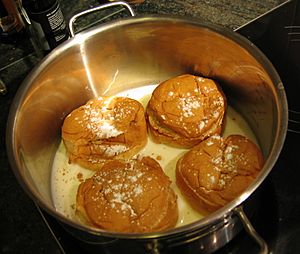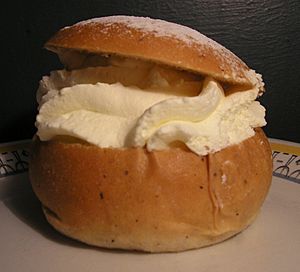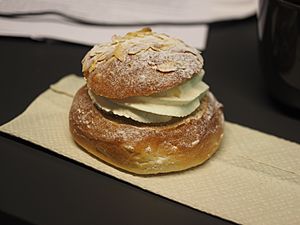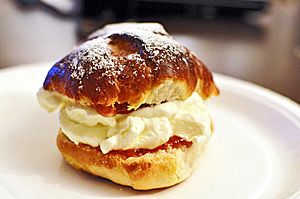Semla facts for kids
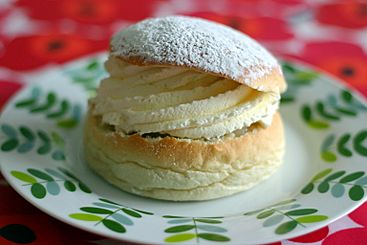
Traditional Swedish semla
|
|||||||
| Alternative names | Laskiaispulla and Lent buns | ||||||
|---|---|---|---|---|---|---|---|
| Type | Sweet roll | ||||||
| Course | Dessert | ||||||
| Place of origin | Sweden or Finland | ||||||
| Region or state | Northern Europe | ||||||
| Associated national cuisine | Sweden | ||||||
| Invented | 1500s | ||||||
| Serving temperature | Medium | ||||||
| Main ingredients | Wheat bread, whipped cream and almond paste | ||||||
| Ingredients generally used | Icing sugar | ||||||
| Variations | Hetvägg | ||||||
| 298 kcal (1248 kJ) | |||||||
|
|||||||
| Similar dishes | Pulla and cardamom bread | ||||||
A semla is a delicious sweet bun enjoyed in many Nordic countries. These include Sweden, Finland, Estonia, Norway, Denmark, the Faroe Islands, Iceland, and Latvia. People often eat semlor around the time of Lent, especially on Shrove Tuesday.
In Sweden, it's usually just called semla. But it has other names too, like fettisdagsbulle, which means "fat Tuesday roll". In Finland, it's known as laskiaispulla, and in Norway and Denmark, it's called fastelavnsbolle. In Iceland, it's a bolla, and in Latvia, vēja kūkas. If you have a semla served in a bowl of hot milk, it's called hetvägg.
Contents
What's in a Name?
The word semla comes from the German word Semmel. This word originally came from the Latin word simila, which means 'flour'. It was used for the best quality wheat flour.
In southern Sweden and among Swedish-speaking people in Finland, these buns are called fastlagsbulle. In Denmark and Norway, they are known as fastelavnsbolle. These names are related to Fastelavn, which is like Shrove Tuesday.
Semla in Sweden and Finland
Today, the semla in Sweden and Finland is a soft wheat bun flavored with cardamom. The top of the bun is cut off, and the inside is filled with a mix of milk and almond paste. Then, it's topped with fluffy whipped cream. The cut-off top acts like a lid and is dusted with powdered sugar.
People often eat semlor on their own with coffee or tea. Some like to eat it in a bowl of hot milk, which is called hetvägg. In Finland, bakeries often fill the bun with strawberry or raspberry jam instead of almond paste. They usually offer both kinds.
Long ago, semlor were only eaten on Shrove Tuesday. This was the last big meal before the fasting period of Lent. But after the Protestant Reformation, people in Sweden stopped strict fasting. So, the semla became a treat enjoyed every Tuesday between Shrove Tuesday and Easter.
Every year, when bakeries start selling semlor, newspapers often have "semla taste tests." Experts try many different semlor to find the best one in town! Some bakeries even make new versions, like a "semmelwrap" that looks like a wrap. Others add chocolate, marzipan, or pistachios to the recipe.
In Finland and Estonia, the tradition of eating these buns is older than Christian customs. The festivals of Laskiaissunnuntai and Laskiaistiistai were times when children would go sledding. They believed that the farther they slid, the better the crops would be that year. This is why the festival is named after the act of sliding downhill. Today, laskiainen is part of the Christian traditions before Easter.
Semla in Norway
In Norway, the bun is called fastelavnsbolle. It's a wheat bun spiced with cardamom. The top is cut off, and it's filled with whipped cream and topped with jam. The cut-off top is put back on like a lid and dusted with powdered sugar. These buns are usually eaten on the Sunday of Fastelavn (Shrove Sunday).
Semla in Denmark, Iceland, and Faroe Islands
In Denmark, the fastelavnsbolle sold in bakeries is a bit different. It's made from puff pastry and filled with whipped cream, a little jam, and often has icing on top. At home, people might bake a version more like a regular wheat roll. They mix plain yeast dough with raisins, succade, and sometimes candied bitter orange peel.
In Iceland, the bun is called bolla. It's similar but often made with choux pastry. Shrove Monday in Iceland is even called bolludagur, which means "bun day," named after this pastry!
In the Faroe Islands, the Føstulávintsbolli is also made with choux pastry. It's filled with vanilla cream, whipped cream, and jam, then topped with chocolate icing.
History of the Semla
The very first semla was a simple bread bun. People would eat it in a bowl of warm milk. In Swedish, this was known as hetvägg.
Originally, the semla was only eaten on Shrove Tuesday. This was the last big meal before the fasting period of Lent. But after the Protestant Reformation, people in Sweden stopped strict fasting. So, the semla in its bowl of warm milk became a traditional dessert enjoyed every Tuesday between Shrove Tuesday and Easter.
Today, you can find semlor in shops and bakeries from shortly after Christmas until Easter. On average, each Swede eats about four to five bakery-made semlor each year, plus any they make at home!
There's a famous story about King Adolf Frederick of Sweden. He died on February 12, 1771, after eating a huge meal. It ended with a serving of hetvägg (semla), which was his favorite dessert. He had problems with his digestion after eating so much.
The semla was chosen to represent Finland in a special event called "Café Europe" in 2006.
Images for kids
See also
 In Spanish: Semla para niños
In Spanish: Semla para niños


